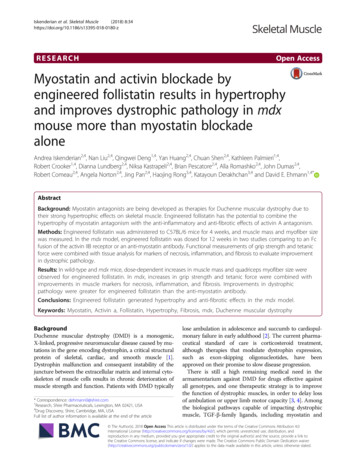
Transcription
Iskenderian et al. Skeletal Muscle(2018) RCHOpen AccessMyostatin and activin blockade byengineered follistatin results in hypertrophyand improves dystrophic pathology in mdxmouse more than myostatin blockadealoneAndrea Iskenderian2,4, Nan Liu2,4, Qingwei Deng1,4, Yan Huang2,4, Chuan Shen2,4, Kathleen Palmieri1,4,Robert Crooker1,4, Dianna Lundberg2,4, Niksa Kastrapeli2,4, Brian Pescatore2,4, Alla Romashko2,4, John Dumas2,4,Robert Comeau2,4, Angela Norton2,4, Jing Pan2,4, Haojing Rong3,4, Katayoun Derakhchan3,4 and David E. Ehmann1,4*AbstractBackground: Myostatin antagonists are being developed as therapies for Duchenne muscular dystrophy due totheir strong hypertrophic effects on skeletal muscle. Engineered follistatin has the potential to combine thehypertrophy of myostatin antagonism with the anti-inflammatory and anti-fibrotic effects of activin A antagonism.Methods: Engineered follistatin was administered to C57BL/6 mice for 4 weeks, and muscle mass and myofiber sizewas measured. In the mdx model, engineered follistatin was dosed for 12 weeks in two studies comparing to an Fcfusion of the activin IIB receptor or an anti-myostatin antibody. Functional measurements of grip strength and tetanicforce were combined with tissue analysis for markers of necrosis, inflammation, and fibrosis to evaluate improvementin dystrophic pathology.Results: In wild-type and mdx mice, dose-dependent increases in muscle mass and quadriceps myofiber size wereobserved for engineered follistatin. In mdx, increases in grip strength and tetanic force were combined withimprovements in muscle markers for necrosis, inflammation, and fibrosis. Improvements in dystrophicpathology were greater for engineered follistatin than the anti-myostatin antibody.Conclusions: Engineered follistatin generated hypertrophy and anti-fibrotic effects in the mdx model.Keywords: Myostatin, Activin a, Follistatin, Hypertrophy, Fibrosis, mdx, Duchenne muscular dystrophyBackgroundDuchenne muscular dystrophy (DMD) is a monogenic,X-linked, progressive neuromuscular disease caused by mutations in the gene encoding dystrophin, a critical structuralprotein of skeletal, cardiac, and smooth muscle [1].Dystrophin malfunction and consequent instability of thejuncture between the extracellular matrix and internal cytoskeleton of muscle cells results in chronic deterioration ofmuscle strength and function. Patients with DMD typically* Correspondence: dehmann0@shire.com1Research, Shire Pharmaceuticals, Lexington, MA 02421, USA4Drug Discovery, Shire, Cambridge, MA, USAFull list of author information is available at the end of the articlelose ambulation in adolescence and succumb to cardiopulmonary failure in early adulthood [2]. The current pharmaceutical standard of care is corticosteroid treatment,although therapies that modulate dystrophin expression,such as exon-skipping oligonucleotides, have beenapproved on their promise to slow disease progression.There is still a high remaining medical need in thearmamentarium against DMD for drugs effective againstall genotypes, and one therapeutic strategy is to improvethe function of dystrophic muscles, in order to delay lossof ambulation or upper limb motor capacity [3, 4]. Amongthe biological pathways capable of impacting dystrophicmuscle, TGF-β-family ligands, including myostatin and The Author(s). 2018 Open Access This article is distributed under the terms of the Creative Commons Attribution 4.0International License (http://creativecommons.org/licenses/by/4.0/), which permits unrestricted use, distribution, andreproduction in any medium, provided you give appropriate credit to the original author(s) and the source, provide a link tothe Creative Commons license, and indicate if changes were made. The Creative Commons Public Domain Dedication o/1.0/) applies to the data made available in this article, unless otherwise stated.
Iskenderian et al. Skeletal Muscle(2018) 8:34activin A, may have the potential to modify disease [5–7].Both ligands employ activin receptors to initiate intracellular signaling that controls the proliferative state of cells.Myostatin, also known as GDF-8, is predominantlyexpressed in skeletal muscle and has been demonstratedto be a negative regulator of skeletal muscle proliferation[8, 9]. In animal models, genetic manipulation of myostatin through gene knockout results in muscle-specifichypertrophy and improved muscle function in the mdxmouse model of DMD [8, 10, 11].Activins are a homologous family of systemicallyexpressed, homodimeric and heterodimeric growth factorsthat were discovered via their primary role in regulatinggonadotropin release from the anterior pituitary [12, 13].In addition to the reproductive axis, activins have beenshown to regulate hepatocyte proliferation and be criticalfor embryonic neurodevelopment [14–16]. Elevated levelsof activin A are found in tissues and serum from a varietyof inflammatory conditions [17, 18]. In dystrophic muscle,the ability of activin A to influence macrophage differentiation and control myofibroblast production suggests thatreducing activin A exposure may decelerate the process ofmuscle degeneration and fibrosis that is a hallmark ofDMD pathology [19–21]. In addition to possible anti-inflammatory effects, lowering of systemic activin A concentrations can impart muscle hypertrophy that appears to beindependent of myostatin pathway signaling [22, 23].As circulating ligands for extracellular receptors,myostatin and activin A are attractive targets forpharmaceutical intervention by functional antagonists.Several biopharmaceutical agents capable of antagonizing binding of myostatin or myostatin and activin Ahave entered clinical development for muscle-wastingdiseases or muscular dystrophies [24–31]. However, thepublished clinical efficacy in sarcopenia or DMD forthese agents has been modest. Possible explanationsinclude a limitation on the pharmacodynamic benefitachievable with pure anti-myostatin agents [32, 33] or alimited therapeutic window such as seen with therecombinant activin type IIB receptor ACE-031 [26].The endogenous ligand-binding partner formyostatin and activin A is follistatin, a systemicallyexpressed, circulating glycoprotein, initially discoveredthrough its effects on regulating secretion offollicle-stimulating hormone [34]. Transgenic mousestudies have shown that dual antagonism of myostatinand activin A by follistatin overexpression has thecapacity to produce larger muscle mass increases thanantagonism of myostatin alone [35, 36]. In the mdxmouse model, follistatin overexpression either throughtransgenes or viral vector delivery resulted inincreased muscle mass and improved dystrophic pathology [37–39]. Delivery of the follistatin gene to dystrophic muscle by local intramuscular injection of anPage 2 of 16adeno-associated virus is currently in clinical trials forDMD [40–43].One challenge to the development of a systemically acting, follistatin-based biopharmaceutical agent is overcoming its rapid systemic clearance rate. Follistatin is a potentbinder of heparin and heparan sulfate-containing proteoglycans, which sequester the protein to the vascular endothelium [44–47]. A previous publication [48] described ourefforts to design a long-acting, follistatin-based moleculenamed FS-EEE-hFc and described its in vitro binding andpharmacokinetic properties. FS-EEE-hFc contains threeglutamate mutations that reduce heparin binding and resultin larger systemic exposure than native follistatin, whileretaining potent binding of myostatin and activin A. Here,we describe the pharmacodynamic properties of FS-EEEhFc, and its mouse surrogate FS-EEE-mFc, to producemuscle mass increases in wild-type mice and to improvedystrophic muscle pathology in the mdx model. Inaddition, in the mdx model, we compare the effects oftreatment with FS-EEE-mFc to treatment with amyostatin-specific antibody and show that improvement inmuscle function and dystrophic pathology is greater withFS-EEE-mFc compared to the anti-myostatin antibody.MethodsAntibodies and protein reagentsFS-EEE-hFc was prepared and purified as described previously [48]. FS-EEE-mFc was prepared by cloning FS315cDNA (Clontech, Mountain View, CA) in frame toClontech mouse spleen cDNA for murine IgG1 Fc. Threeamino acids, K76, K81, and K82, were mutagenized to glutamic acid by replacement with a mutated DNA sequence,which was synthesized by ATUM (Newark, CA). The plasmid was transfected into CHO GS cells (Sigma, St. Louis,MO) by electroporation. The cells were cultured inEX-Cell CD CHO Fusion media (Sigma) under standardcondition (5% CO2, 37 C) and selected for 10 days togenerate stable pools. FS-EEE-mFc protein stably secretedin cell culture supernatant was captured onto a HiTrapMabSelect SuRe column (GE Healthcare Bio-Science,Piscataway, NJ) under high salt condition (2.5 M NaCl)and eluted using a step-gradient of 100 mM sodium citrate,pH 2.5. The protein was neutralized to pH 7.0 by adding1 M Tris buffer, pH 9.0. Impurities were further removedusing a Superdex 200 26/600 column (GE HealthcareBio-Science). Purity of the final protein was 95% asanalyzed by size-exclusion chromatography [49] analysis.Recombinant mouse activin RIIB Fc chimera protein waspurchased from R&D Systems (Minneapolis, MN). Theanti-myostatin antibody was constructed using sequencesfrom OGD1.0.0 [50] within a mouse IGKV6 light chain, amouse IGHV5 heavy variable chain, and a mouse IGHG1heavy constant chain. The monoclonal antibody was transiently expressed in CHOZN-EBNA cells (Sigma). Protein
Iskenderian et al. Skeletal Muscle(2018) 8:34expression was carried out as a fed-batch culture inFed-Batch Media (SAFC Biosciences, Lenexa, KS) over14 days with daily feeds of 3% v/v SAFC Advanced Feed 1.Purification was achieved by capturing the conditionedmedia on MabSelect SuRe resin, followed by Q and SP column steps. The resulting purified protein was dialyzed intoPBS pH 7.4 and had 99% purity by SEC.AnimalsMale C57BL/6J mice, aged 8–9 weeks, were obtained fromJackson Laboratories (Bar Harbor, ME) and acclimated for1 week prior to start of study. For all studies, mice werehoused in groups of up to five per cage in a colony roomunder a 12-h light-dark cycle, targeted humidity (50% 20%) and temperature (22 C 3 C). Rodent diet(LabDiet-5001, St Louis, MO) and water (Lexington, MAmunicipal water purified by reverse osmosis) were availablead libitum for the duration of the experiment. Male mdxmice (C57BL/10ScSn-Dmd mdx /J) and C57BL/10ScSnJwere sourced from Jackson Laboratories and bred toobtain animals for the study. Mice were balanced acrosstreatment groups using body weight at 3 weeks ( 3 days)of age for the unexercised study and 5 weeks for the exercised study. To prevent litter effects, mdx animals fromthe same litter were distributed across groups. During thecourse of the study, 12 h/12 h light/dark cycles (unexercised), 13 h/11 h light/dark cycles (exercised), and a roomtemperature of 20 to 23 C were maintained with a relativehumidity maintained around 50%. Food and water wereprovided ad libitum for the duration of the study. Allassessments were performed during the animals’ light cyclephase with dose groups randomized and test article identifications blinded. For treadmill exercise, mice were placedon a treadmill (Columbus Instruments, Columbus, OH)set at a 0 incline one at a time (up to five mice per lane) ina lane and run for 30 min at a maximum speed of 12 mper minute, twice a week.Dosing and blood samplingIV administration of the FS-EEE-mFc and FS-EEE-hFc wasperformed using tail vein injection. For subcutaneous (SC)injections, a ½ cc insulin syringe containing a 27 gaugeneedle was filled with test articles diluted in PBS to 1–2 mg/mL, and animals injected in the interscapular area.Blood was collected via submandibular bleeds prior todosing at timepoints indicated. A terminal bleed was alsoconducted 24 h post last dose. Whole blood was collectedin Becton Dickinson (Franklin Lakes, NJ) Microtainer serum separator tubes and processed as directed.Grip strengthGrip strength was measured on a Chatillion DFE II ForceGauge (San Diego Instruments, San Diego, CA) for theunexercised study and a Grip Strength Meter (ColumbusPage 3 of 16Instruments, Columbus, OH) for the exercised study.Animals were tested in five consecutive trials. At an angleof 0 , in one continuous, fluid motion, animals’ forelimbgrip strengths were assessed. In the unexercised study,grip strength was measured on one day after 11.5 weeksof dosing. In the exercised study, animals were acclimatedto the grip strength apparatus by 5 days of unrecordedtesting during week 9 followed by 5 days of recordedtesting during week 10.Exhaustion assayIn the exercised study, the exhaustion assay was performedusing a treadmill with four lanes and a running plane of 0 .Mice were randomized such that each mouse running inone apparatus was from a different treatment group. Aftera 5 min at 5 m/min acclimation period, the speed of thetreadmill was increased by 1 m/min every minute until themice were exhausted, as defined by inability to continuerunning for 20 consecutive seconds despite repeated gentlenudges. The exhaustion assay was performed on eachmouse three times with a day of rest in between testingdays and the average distance of running (m) wasmeasured.Ex vivo force muscle contractionsContractile properties were measured ex vivo on the EDLmuscle at the end of the study. Mice were anesthetized,and the EDL muscle of the right hindlimb was removedfrom each mouse and immersed in an oxygenated bath(95% O2, 5% CO2) containing Ringer’s solution (pH 7.4) at25 C. The muscle was flanked by two electrodes, and usingnon-fatiguing twitches, the muscle was adjusted to the optimal length for force generation. The force frequency curvewas generated using 30, 80, 100, 150, 180, 200, and 250 Hz.The maximal force was measured with the muscle held atoptimal length. The muscles were stimulated withelectrodes to elicit tetanic contractions that were separatedby 2-min rest intervals. With each subsequent tetanus, thestimulation frequency was increased in steps of 20, 30, or50 Hz until the force reached a plateau which usuallyoccurred around 250 Hz. That plateau was considered themaximum force [51] generated by the muscle. Thecross-sectional area (CSA) of the muscle calculated usingthe formula below was measured based on muscle mass(value obtained using calibrated analytic scale), optimalfiber length (using a vernier caliper), and tissue density.Muscle-specific force (kN/m2) was calculated based on thecross-sectional area of the muscle calculated as follows.CSA muscle mass/(optimal length of the EDL 0.45 1.056). The fiber to muscle length ratio is 0.45. The densityof muscle is 1.056. Optimal length was measured when theEDL produced the maximal tetanus force.
Iskenderian et al. Skeletal Muscle(2018) 8:34Page 4 of 16Serum biomarkersAnti-MST mAb bioanalysisCreatine kinase was measured in serum samples using aCobas C311 Clinical Chemistry Analyzer (Roche). Sampleswere diluted 1:16 in RODI water and analyzed using a Creatine Kinase test kit (Roche, Cat# 4524977190). Sampleswere analyzed along with the appropriate assay calibrator(Roche C.F.A.S, Cat# 10759350360) and controls (RochePrecinorm U Plus, cat#1214935160, and Precipath U Plus,cat#12149443160). Muscle injury markers sTn1 and cTn1were measured in serum samples using Muscle Injurypanel 3 (MSD, Rockville, MD #K15186C-5) according tothe manufacturer’s instructions. Mouse serum sampleswere prepared by diluting the serum eightfold in Diluent33 with EDTA and DTT added. Twenty-five microliters perwell of samples and standards were loaded onto the MSDplates and incubated at 25 C for 2 h with vigorous shaking(300–1000 rpm). After the incubation plates were washedthree times with 300 uL/well of PBST, twenty-five microliters per well of sulfo-tagged detection antibody solutionwas added and plates were incubated for an additional 2 hwith vigorous shaking at 25 C. Plates were washed threetimes with 300 uL/well of PBST. One hundred fifty microliters of 1 Read Buffer T was added to each well and plateswere read with a MSD SECTOR imager.Mouse serum concentrations of Anti-MST mAb weredetermined using an electro-chemiluminescent immunoassay. Meso Scale Discovery (MSD, Rockville, MD) standard plates were coated with 10 ng/well recombinanthuman/mouse/rat GDF-8/Myostatin (R&D Systems,788-G8-010) in PBS, 30 μL/well. After overnight incubation at 4 C, plates were washed three times with washbuffer [1 Dulbecco’s PBS (Gibco #14190-136 or equivalent) 0.02% Tween 20] and then blocked with 150 μL/well 2.5% BSA 0.05% Casein 0.05% Tween 20 and incubated at 25 C for 1 h with shaking. After washing threetimes with wash buffer, samples, controls, and a standardcurve of Anti-MST mAb from 125 to 0.977 ng/mL wereadded to the plate, 25 μL/well. Samples, controls, andstandards were diluted in 1% mouse serum matrix ifrequired dilutions were beyond 1:100. After incubation at25 C for 1 h with shaking, and then washing three timeswith wash buffer, 1 μg/mL Sulfo-tag labeled goatanti-mouse Ab (MSD, R32AC-1) was added, 25 μL/well.After incubation at 25 C for 1 h with shaking, and washing three times with wash buffer, 1 Read Buffer T (MSD)was added, 150 μL/well. Plates were read with a MSDSECTOR imager and concentrations determined relativeto the standard curve, adjusted for dilutions.FS-EEE-mFc bioanalysisTissue collectionMouse serum concentrations of FS-EEE-mFc were determined using an electro-chemiluminescent immunoassay.Meso Scale Discovery (MSD, Rockville, MD) standardplates were coated with 2.5 μg/mL goat anti-human Follistatin Ab (R&D Systems, AF669) in PBS, 50 μL/well.After overnight incubation at 4 C, plates were washedthree times with wash buffer [1 Dulbecco’s PBS (Gibco#14190-136 or equivalent) 0.02% Tween 20] and thenblocked with 150 μL/well 0.5% Blocker B/2.5% BlockerA (MSD) and incubated at 25 C for 1 h with shaking.After washing three times with wash buffer, samples anda standard curve of FS-EEE-mFc from 12.5 to 0.098 ng/mL were added, 25 μL/well. Samples, controls, andstandards were diluted in 10% mouse serum matrix ifrequired dilutions were beyond 1:10. After washing threetimes with wash buffer, a 1:8000 dilution of rabbitanti-mouse IgG1 (Abcam, Cambridge, MA, ab125913),diluted in 0.5% Blocker B/2.5% Blocker A, was added,25 μL/well. After incubation at 25 C for 1 h with shaking, and then washing three times with wash buffer,1 μg/mL Sulfo-tag labeled goat anti-rabbit Ab (MSD,R32AB-1) was added, 25 μL/well. After incubation at25 C for 1 h with shaking, and washing three times withwash buffer, 1 Read Buffer T (MSD) was added,150 μL/well. Plates were read with a MSD SECTORimager and concentrations determined relative to thestandard curve, adjusted for dilutions.Animals were anesthetized with sodium pentobarbital andperfused with saline. For the diaphragm, right side wasimmediately placed into RNALater solution. Once thesample was submerged, clean blades were used to cut thesample into smaller pieces and then stored at 4 C for24 h. After 24 h, remaining RNALater Solution wasremoved and tissue samples were then immediately placedon dry ice, prior to storage at 80 C. The left side of thediaphragm with attached rib cage was dropped fixed in10% neutral buffered formalin (NBF) for 72 h and thentransferred to 70% alcohol for storage at 4 C. Quadricepstissue was handled as above with right side stored inRNALater solution and left side fixed in 10% NBF.Histological analysisThe fixed tissues were processed for paraffin embedding,and 5-μm sections were prepared. Hematoxylin and eosin(H&E) staining was performed following standard procedure for a Leica stainer. The stained slides were scannedwith an Aperio ScanScope AT2 scanner. The digital slideswere
Robert Comeau2,4,AngelaNorton2,4, Jing Pan2,4,HaojingRong3,4,KatayounDerakhchan3,4 and David E. Ehmann1,4* Abstract Background: Myostatin antagonists are being developed as therapies for Duchenne muscular dystrophy due to their strong hypertrophic effects on skeletal muscle











